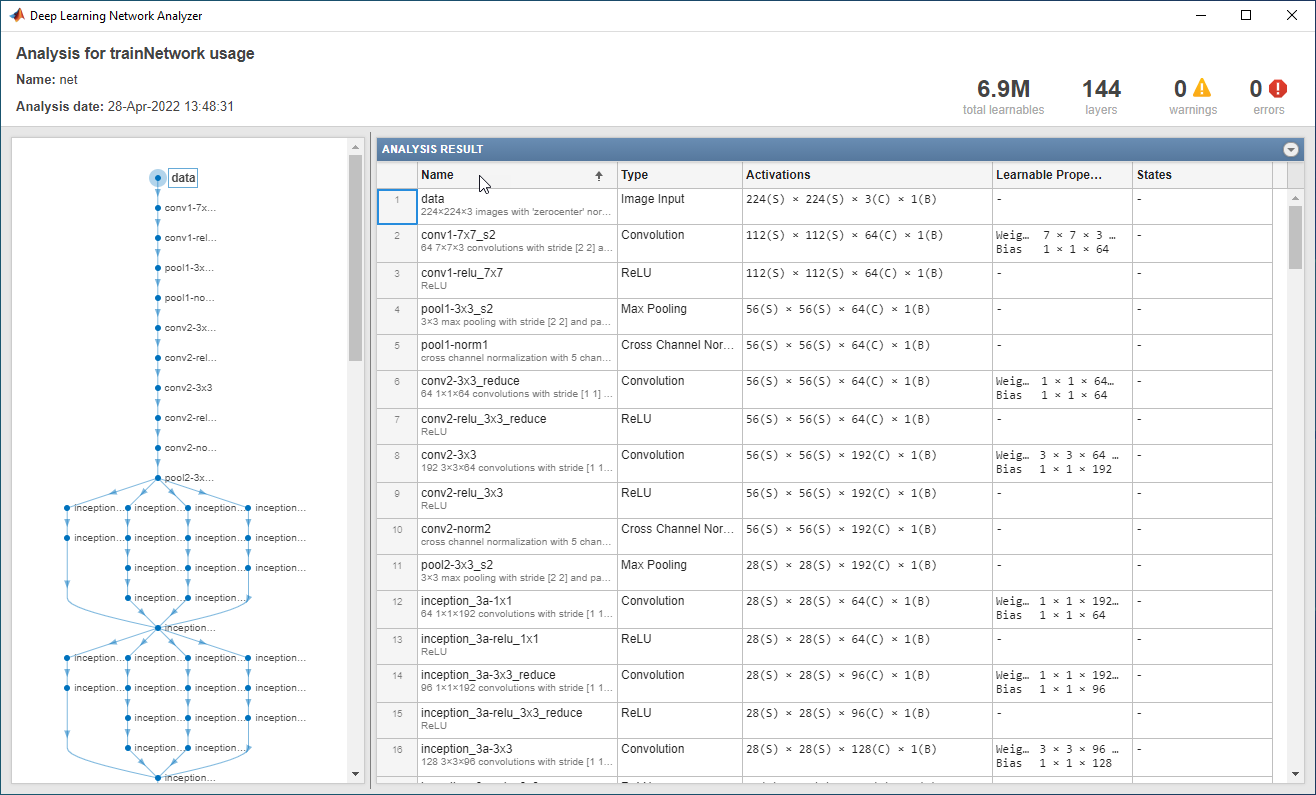Generate Code for Deep Learning Networks Using MATLAB Function Block
You can generate optimized code for Simulink® models containing a variety of trained deep learning networks. You can implement
the deep learning functionality in Simulink by using MATLAB Function blocks or by using blocks
from the Deep Neural Networks library. When implementing deep learning
functionality with MATLAB® Function blocks, use the coder.loadDeepLearningNetwork function to load a trained deep learning network
and use the object functions of the network object to obtain the desired responses. You can
configure the code generator to take advantage of the Intel® Math Kernel library for Deep Neural Networks (MKL-DNN). You can also generate
generic C or C++ code that does not depend on third-party libraries. The generated code
implements the deep convolutional neural network (CNN) by using the architecture, the layers,
and parameters that you specify in a network object.
Classify Images by Using GoogLeNet
GoogLeNet is a convolutional neural network that is 22 layers deep. The network has been trained on over a million images and can classify an image into 1000 object categories (such as a keyboard, coffee mug, pencil, and animals).The network takes an image as input, and then outputs a label for the object in the image together with the probabilities for each of the object categories. This example shows you how to perform simulation and generate C++ code for the pretrained GoogLeNet deep convolutional neural network and classify an image.
Load the pretrained GoogLeNet network. You can choose to load a different pretrained network for image classification. This function requires the Deep Learning Toolbox™ Model for GoogLeNet Network support package. If this support package is not installed, then the function provides a download link.
net = googlenet;
The object
netcontains theDAGNetworkobject. Use the function to display an interactive visualization of the network architecture, to detect errors and issues in the network, and to display detailed information about the network layers. The layer information includes the sizes of layer activations and learnable parameters, the total number of learnable parameters, and the sizes of state parameters of recurrent layers.analyzeNetwork(net);

The image that you want to classify must have the same size as the input size of the network. For GoogLeNet, the size of the
imageInputLayeris 224-by-224-by-3. TheClassesproperty of the outputclassificationLayercontains the names the names of the classes learned by the network. View 10 random class names out of the total of 1000.classNames = net.Layers(end).Classes; numClasses = numel(classNames); disp(classNames(randperm(numClasses,10)))
speedboat window screen isopod wooden spoon lipstick drake hyena dumbbell strawberry custard apple
Create GoogLeNet Model
Create a Simulink model and insert a MATLAB Function block from the User-Defined Functions library.
Add an Image From File block from the Computer Vision Toolbox™ library and set the
File nameparameter topeppers.png.Add a Resize block from the Computer Vision Toolbox library to the model. Set the Specify parameter of the Resize block to
Number of output rows and columnsand enter[224 224]as the value for Number of output rows and columns. This block resizes the input image to that of the input layer of the network.
Double-click the MATLAB Function block. A default function signature appears in the MATLAB Function Block Editor.
Define a function called
googlenet_predict, which implements the prediction entry-point function. The function header declaresinas an argument to thegooglenet_predictfunction, withscoresandindxTopas the return value.function [scores,indxTop] = googlenet_predict(in) %#codegen persistent mynet; if isempty(mynet) mynet = coder.loadDeepLearningNetwork('googlenet'); end % pass in input predict_scores = predict(mynet,in); [scores,indx] = sort(predict_scores, 'descend'); indxTop = indx(1:5);
A persistent object
mynetloads theDAGNetworkobject. At the first call to the entry-point function, the persistent object is constructed and set up. On subsequent calls to the function, the same object is reused to callpredicton inputs, avoiding reconstructing and reloading the network object.You can use the
activations(Deep Learning Toolbox) method to network activations for a specific layer. For example, the following line of code returns the network activations for the layer specified inlayerIdx.out = activations(mynet,in,layerIdx,'OutputAs','Channels');
You can use the
classify(Deep Learning Toolbox) method to predict class labels for the image data ininusing the trained networkmynet.[out,scores] = classify(mynet,in);
For LSTM networks, you can use the
predictAndUpdateState(Deep Learning Toolbox) andresetState(Deep Learning Toolbox) methods.Open the block parameters of the MATLAB Function block. On the Code Generation tab, select
Reusable functionfor Function packaging.Connect these blocks as shown in the diagram. Save the model as
googlenetModel.
Simulate Model
Open the Configuration Parameters dialog box. Select the Solver pane. Set the Type parameter to
Fixed-step. This setting maintains a constant (fixed) step size, which is required for code generation.Select the Simulation Target pane. Set the Language to
C++.On the Simulation Target pane, set the Target Library parameter in the Deep learning group to
MKL-DNN.Click OK to save and close the Configuration Parameters dialog box.
To build and simulate the model, use this command:
out = sim('googlenetModel');Display the top five predicted labels and their associated probabilities as a histogram. Because the network classifies images into so many object categories, and many categories are similar, it is common to consider the top-five accuracy when evaluating networks. The network classifies the image as a bell pepper with a high probability.
im = imread('peppers.png'); classNamesTop = classNames(out.yout{2}.Values.Data(:,:,1)) h = figure; h.Position(3) = 2*h.Position(3); ax1 = subplot(1,2,1); ax2 = subplot(1,2,2); image(ax1,im); barh(ax2,out.yout{1}.Values.Data(1,5:-1:1,1)) xlabel(ax2,'Probability') yticklabels(ax2,classNamesTop(5:-1:1)) ax2.YAxisLocation = 'right'; sgtitle('Top 5 predictions using GoogLeNet')

Generate Code
Open the Simulink Coder or Embedded Coder app. The C Code tab opens.
In the Configuration Parameters dialog box, if you have a Simulink Coder™ license, set the System target file to
grt.tlc. If you have Embedded Coder®, set the System target file parameter toert.tlc.Set the Language to
C++.Select Generate code only.
On the Code Generation > Interface pane, set the Target Library in the Deep learning group to
MKL-DNN.Clear the MAT-file logging parameter.
Click OK to save and close the Configuration Parameters dialog box.
On the C++ Code app, click Generate Code.
See Also
googlenet (Deep Learning Toolbox) | Image From File (Computer Vision Toolbox) | MATLAB Function